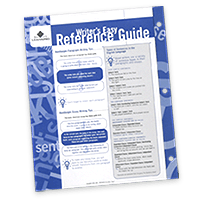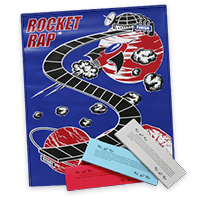The Complex Auditory System
It is important to remember that hearing is not a based on only one sensory-perceptual skill. The central auditory nervous system (CANS) is a complex system with multiple components (sub-categories) and levels. Anatomically, the auditory system includes nuclei and pathways in the brainstem, subcortex, primary and association areas of the cortex and corpus collosum. Much of what constitutes central auditory processing is pre-conscious. That is, it occurs before a listener’s conscious awareness. What is experienced by the listener is an auditory perceptual event (Plomp, 1976; Tyler, 1992; Warren, 1984).
Although the CANS is critical to auditory functions, including spoken language processing and many other complex signals, several other factors are involved as well. Even the simplest auditory tasks are influenced by such higher-level, non-modality-specific factors as attention, learning, motivation, memory, and decision processes. Higher level contextual information influences the perceptual analysis of the acoustic signal, and various knowledge sources interact and support the auditory processing of spoken language and other complex acoustic signals, such as music (Bregman, 1990; Duetch, 1975, 1982;Handel, 1984, 1989; Jones, 1987; McAdams & Bregman, 1979; McAdams & Saariaho, 1985).
Dyslexia and the Auditory System
Those with dyslexia were found to have reduced neural integration of letter-speech sounds in the auditory cortex. They also typically had reduced brain activity when processing speech sounds. The auditory cortex is part of the central auditory nervous system. This is the system that is responsible for auditory processing; recognizing, interpreting and processing sound.
Reduced neural integration and brain activity in the auditory cortex is likely to negatively affect sound identification, discrimination, and representation. These findings confirm that letter-speech sound integration, in the auditory cortex, is important in learning to read and that it develops differently in those with reading disorders
(Blau et al., 2009).
Auditory Processing Disorder and Reading Difficulties
California Reading Initiative
Critical Ideas Focusing on Meaningful Reform
Looking at the validated research, struggling readers become far more successful when they are taught the same fundamental reading skills that all students need to learn. However, struggling students require increased instructional time, more structures sequenced teaching, and more feedback.
We also know that students with severe reading problems typically have weaknesses in auditory processing, especially phonemic awareness and auditory-visual integration, the sound/symbol relationship. Struggling readers need a balance of instruction including systematic, explicit phonics, decoding and encoding, vocabulary and comprehension strategies.
Reading programs that are effective use specific strategies, explicit instruction, decoding, encoding, fluency, vocabulary, and comprehension strategies.
Auditory Processing directly impacts reading skills. The basis of reading is phonemic awareness and phonics (the alphabetic principle). When you have areas of auditory processing that are not working as well as they could, should, and can, reading becomes very difficult. The term developmental dyslexia refers to those children that struggle with reading because their brains do not process fast-changing sounds properly. Studies have shown that auditory processing training directly impacts and rewires the brain, making reading easier.
Neural deficits in children with dyslexia ameliorated by behavioral remediation: Evidence from functional MRI
- Elise Temple†‡,
- Gayle K. Deutsch§,
- Russell A. Poldrack¶,
- Steven L. Miller‖,
- Paula Tallal‖‡‡,
- Michael M. Merzenich‖††, and
- John D. E. Gabrieli†§
Behavioral Results
The children with dyslexia improved significantly in reading ability, as measured by tests of real word reading (Word Identification), pseudo-word decoding (a measure of phonological awareness) (Word Attack), and passage comprehension (Table 2). The improvements on these three tests raised the dyslexic group’s scores into the normal range (>85). Children with dyslexia also improved in oral language ability and rapid naming. The extent of improvement was significant as measured by paired t tests for each test (Table 2). However, there was individual variability in the extent of improvement. For reading (as measured by a composite Basic Reading Score), one child had <0 and eight children had <5 points improvement. For language ability (as measured by a composite Total Language score), five children had close to or <0 and five children had close to 5 points improvement. We were unable to determine what factors were reliable predictors of extent of improvement. Neither the dyslexic nor control groups showed a change in performance on the letter rhyme task performed during fMRI (percent accuracy: dyslexics: pretraining = 71.2, posttraining = 76.0, P > 0.1; controls: pretraining = 83.1, posttraining = 84.1).
http://www.pnas.org/content/100/5/2860.full
Sound Training Rewires Dyslexic Children’s Brains for Reading
Developmental Medicine Center at Children’s Hospital Boston/Harvard Medical School reports that repetitive exercising of auditory processing intervention programs had a direct positive impact on children with developmental dyslexia.
After training the children listened again to the fast and slowly changing sounds while in the fMRI scanner. After training, the children with dyslexia showed brain activity much more like that of the typical reading group. Furthermore, the dyslexic children’s reading scores as a group improved significantly after training (even though the training did not involve reading per se), moving them into the low end of the typical reading range. Hence the initially described differences in brains of children with developmental dyslexia and typical readers can be changed through intensive training.
Gray matter volume changes following reading intervention in dyslexic children
This study showed gains in reading skills and increased GMV (Gray Matter Volume) in dyslexic children after an eight-week reading intervention. GMV increases were observed in the left hemisphere in anterior fusiform/hippocampus and precuneus. The left anterior fusiform region is commonly engaged in tasks involving object processing and object naming and may suggest that the dyslexic students are relying on this region to help improve their processing of words. The left precuneus has been implicated in visual imagery and specifically in tasks involving imagery of individual letters. Right hemisphere GMV changes following the intervention were found in the cerebellum and hippocampus. There is a theoretical framework implicating the cerebellum in dyslexia and this study adds a novel contribution to this theory. Finally, the GMV increases in the left hippocampus (extending from the cluster reported for the anterior fusiform gyrus) and right hippocampus may reflect more general learning that is occurring during the intervention. The increases in GMV were restricted to the intervention period and were not observed after the intervention ended, suggesting that these increases in GMV are related to the intervention. This is the first longitudinal VBM analysis in children and demonstrates that changes in brain structure are brought about by intervention. These findings provide encouragement that learning can result in both lasting behavioral and structural changes in children who struggle in learning to read.
http://www.ncbi.nlm.nih.gov/pmc/articles/PMC3073149/
Auditory processing, phonemic awareness, phonics, and fluency training that is explicit
and sequential is what made the difference.
Bonnie Terry’s methods teach the synthesis of phonemes into words while addressing auditory processing.
The spelling lessons in Bonnie Terry Learning’s (BTL) ASW Spelling Program, Making Spelling Sense,and Making Spelling Sense II use a method that teaches both this process and the structure of the language. Each lesson teaches both the spelling patterns and the words, one letter or blended letters at a time, and the student then blends all of the letters together to form words.
The (BTL) ASW VAK Program, ASW Reading, Writing, and Study Skills Program, and Five Minutes to Better Reading Skills all teach syllable segmentation, segmentation of individual phonemes, blending, and fluency.
The ASW VAK Program teaches all nine areas of auditory perception, the nine areas of visual processing and the nine areas of tactile/kinesthetic processing. This includes the above steps.



















